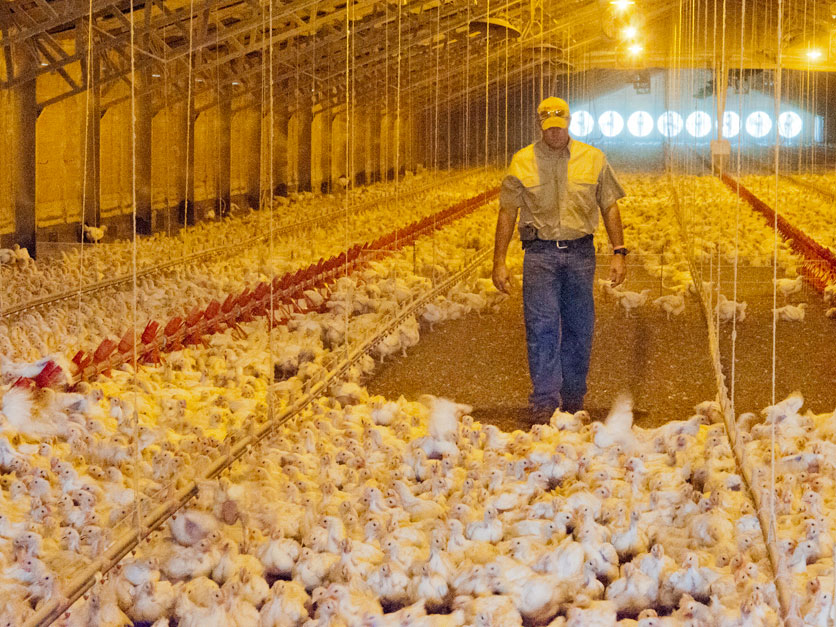Poultry integrators will have to provide more financial information to prospective or current growers before entering into contracts with them, under a USDA final rule designed to increase transparency and prevent discrimination in the industry.
Released Wednesday, the rule would require dealers to disclose their average annual gross payments over a five-year span and information about the variable costs associated with broiler production. They would also be required to disclose previous litigation history involving broiler growers; any bankruptcy filings from the past five years; policies and procedures regarding the sale of the grower's farm, and the average annual turnover rate for broiler growers from the previous five years.
The rule would also require poultry dealers to share flock information — including stocking density, breed names and ratios, and breeder flock age — within 24 hours of delivering poultry under a "grower ranking," or tournament, system.
Poultry dealers that slaughter fewer than 2 million live pounds of broilers weekly or 104 million pounds annually will be exempt from some of the requirements, according to a USDA press release.
"At the end of the day, it really is an effort to try to avoid unfairness or deception or discriminatory practices in contracting relationships between growers and integrators," Vilsack told reporters on a press call Wednesday.
The rule received a mixed response from across the poultry industry when first proposed. Some commenters didn't believe it went far enough to eliminate or reshape the tournament system, while others believed it wasn't needed.
On Wednesday, the National Chicken Council called the rule "costly and unnecessary."
“Make no mistake, this isn’t about transparency,” NCC President Mike Brown said in a press release. “This rule was specifically designed to chum the water for lawsuits. It is just the first salvo in the administration’s attempts to resurrect failed policies that would dismantle a successful industry structure that has benefited farmers, chicken companies and ultimately consumers all around the world."
Specifically, NCC said "it appears the industry could have to retroactively amend 25,000 contracts in two months over three major federal holidays." The group also said USDA has "failed to consider the risks of frivolous litigation, industry-wide efficiency losses, costs to farmers and consumers from new regulatory burdens, and the effects on inflation."
Steve Etka, policy director for the Campaign for Contract Agriculture Reform, applauded the final rule, which he said will help deter "deception" by poultry companies and "give farmers the information they need to make wise investment decisions." CCAR is a coalition of eight non-profit organizations, including the National Farmers Union, National Sustainable Agriculture Coalition and R-Calf USA.
"Without a doubt, a full-scale reform of the poultry payment system is needed, but this rule is a very important and welcomed step toward that goal,” Etka said in a release.
Emily Miller, an attorney for Food and Water Watch, said in a release that the rule did not go far enough in providing farmers with "meaningful protections" under the Packers and Stockyards Act.
"USDA must do more to actually protect farmers from corporate abuse, beyond merely informing producers how exploitative the system is," Miller said in a release. "The Biden Administration must move quickly to finalize the remaining Packers & Stockyards Act rules and stop capitulating to industry demands that serve only to maintain the status quo."
Vilsack said the rule will be published in the Federal Register "within a matter of days." The regulations will go into effect 75 days after that.
The final rule comes amid a slate of USDA announcements intended to address competition issues across the agriculture industry, which include the creation of a Chief Competition Officer position at the Agricultural Marketing Service (AMS), a warning to seed companies to comply with labeling requirements under the Federal Seed Act, and an update to agency policy clarifying that USDA-purchased meat must come from animals born, raised and slaughtered in the U.S.
It’s easy to be “in the know” about what’s happening in Washington, D.C. Sign up for a FREE month of Agri-Pulse news! Simply click here.
The Chief Competition Officer position is intended to increase coordination between USDA investigators and legal staff, as well as with outside agencies like the Justice Department, according to Andy Green, who was hired by the USDA in 2021 to advise on competition.
"It's really important that we have an elevated, institutionalized leader here at AMS that will be able to do that work, build the policy, bridge those gaps," Green said during the press call.
AMS updated its purchasing guidelines to require meat products to be bought from animals that are born, raised and slaughtered in the U.S. A press release from the agency said previous guidelines were "not as clear" as those for other commodities.
Ethan Lane, vice president of government affairs for the National Cattlemen's Beef Association, said he doesn't see agency officials' recent "born, raised and slaughtered" clarification as "much of a departure from their Buy American strategy that they've been talking about for the last couple of years."
"Certainly a requirement like this for sourcing in those programs at USDA would be in line with the proposed Product of the USDA rulemaking that's currently working its way through the system," he said.
Sarah Little, the vice president of communications for the North American Meat Institute, said the policy could have cost impacts.
"Segregation of cattle to those born, raised and slaughtered in the U.S. will increase costs and will place the burden on school systems and the taxpayer at a time of great need," Little said in a statement to Agri-Pulse. "We will need to review the policy and the costs of compliance."
For more news, go to www.Agri-Pulse.com.
Spencer Chase contributed to this article.
Editors note: This story has been updated to include comments from the North American Meat Institute and Food and Water Watch.


